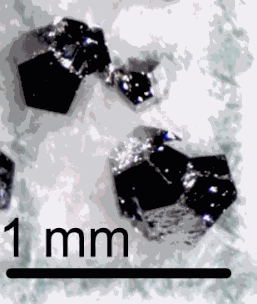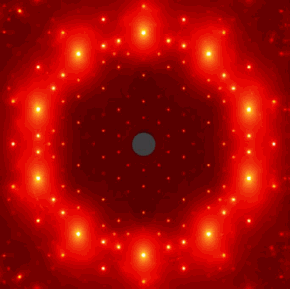Just as fishing experts know that casting a line in the right spot hooks the big catch, scientists from the U.S. Department of Energy Office of Science's (DOE-SC's) Ames Laboratory used an algorithm they developed, and the high-brightness x-ray beams from the DOE-SC's Argonne National Laboratory Advanced Photon Source to hone in on just the right spot for discovering a new family of rare-earth quasicrystals. Their research resulted in finding the only known magnetic rare earth icosahedral binary quasicrystals, providing a "matched set" of magnetic quasicrystals and their closely related periodic cousins. The discovery was been published online by the journal Nature Materials.
"This discovery of binary magnetic quasicrystals provides us with a means of doing a cleaner comparison of structural and magnetic properties between a quasicrystal and its periodic approximant," said Alan Goldman, Ames Laboratory faculty scientist and a distinguished professor at Iowa State University. "It's a tremendously exciting thing."
Goldman is part of the Ames Laboratory research group that studies the microscopic properties of crystals utilizing neutron scattering, and x-ray scattering performed at the Advanced Photon Source. His collaborator, Ames Lab faculty scientist and Iowa State University distinguished professor Paul Canfield, was one of the first scientists to grow single-grain, rare-earth quasicrystals, and his work continues in discovering, growing, and characterizing them.
Quasicrystals are intermetallic compounds that are ordered but not periodic. The properties they exhibit (non-sticking, hardness, corrosion resistance, low thermal conductivity) make them candidates for a number of applications, from hydrogen storage to cylinder liners and piston coatings that could reduce air pollution and increase engine lifetimes, to coatings on metallic parts used for bone repair and prostheses.
Since their discovery in 1982 by Nobel Prize-winning chemist Dan Shechtman, many quasicrystals have been synthesized by researchers worldwide, and one has even been discovered occurring naturally.
But scientists at the Ames Laboratory, with their expertise in rare earths and magnetism, were beginning to look for the next step after that revolutionary first discovery.
"For the last ten years, we have been moving beyond just the innate beauty of these quasicrystalline structures to find out what else is interesting about them. Are the electrical properties any different? Are the magnetic qualities unusual?" Goldman said.
Goldman and Canfield, like many researchers around the world, began to wonder what magnetic properties would do, extended to the unique design of quasicrystals.
"If you could place magnetism on these quasicrystal structures, what would it look like?" Canfield said. "You can have antiferromagnets or ferromagnets in the crystalline or periodic example. You have a disordered magnet or spin glass with the amorphous system. This is known. But with quasicrystals, you have an aperiodic arrangement. Will it affect the magnetism in some weird or novel way? It's a strange environment for magnetism."
"There's been a lot of theoretical and experimental work on magnetic quasicrystals, and mathematically there's no reason why magnetic ordering can't happen," said Goldman. "But experimentally it was never observed. Why? What does this teach us about magnetism in complex environments?"
A few years ago, researchers in Japan discovered a series of periodic approximants of rare-earth cadmium did order magnetically. (Approximants are materials can be found close to crystalline phases that contain similar atomic motifs.) The Ames Laboratory scientists, in collaboration with colleagues from France, Japan, and the United States worked to characterize the approximants by scattering the magnetic structures.
Goldman and Canfield suspected that there could be quasicrystals very close to these rare earth cadmium approximants, hidden in very limited regions of temperature and composition space in the phase diagram, and most easily attainable through the flux growth method Canfield has used to grow other quasicrystals. Together with Ames Lab scientists Sergey Bud'ko, Andreas Kreyssig, Kevin Dennis, Mehmet Ramazanoglu, Anton Jesche, and physics graduate student Tai Kong, Goldman and Canfield initiated a new search for magnetic quasicrystals.
Goldman asked Canfield to start by growing the approximant, but Canfield was shooting for both.
"My intent was not just to go to the approximant; I was fishing for the binary quasicrystal," Canfield said. "It was an attempt to survey the system. I know there's an approximant in there, but is there another surprise?" And sure enough, there was.
Canfield had grown the approximant, but he also found the presence of faceted pentagonal dodecahedra, one of the signatures of quasicrystals. Goldman's x-ray scattering work confirmed the material as a quasicrystal.
X-ray powder diffraction, using a conventional laboratory source, and high-energy x-ray single-grain diffraction utilizing X-ray Science Division beamline 6-ID-D at the DOE Office of Science's Advanced Photon Source, were employed to characterize and index the diffraction patterns from several of the rare earth icosahedral binary quasicrystals discovered by the research team.
In the rare earth cadmium approximants, there is magnetic order. In the quasicrystalline materials, however, the scientists found spin-glass behavior, similar to the magnetic behavior in amorphous materials.
"What we have here is proof of principle. Yes, you can find quasicrystals near approximants; you just have to search the right way," said Canfield.
"There's still work to be done; it's my hope that there is lurking out there a quasicrystalline antiferromagnet, which means an ordered magnetic structure. It hasn't been theoretically ruled out," said Goldman. "What I do know is that quasicrystals continue to surprise me."
See: Alan I. Goldman1,2*, Tai Kong1,2, Andreas Kreyssig1,2, Anton Jesche1,2, Mehmet Ramazanoglu1,2, KevinW. Dennis1, Sergey L. Bud'ko1,2, and Paul C. Canfield1,2**, "A family of binary magnetic icosahedral quasicrystals based on rare earths and cadmium," Nat. Mater., published online 09 June 2013. DOI:10.1038/nmat3672
Author affiliations: 1Ames Laboratory, 2Iowa State University
Correspondence: *[email protected], **[email protected]
The Ames Lab press release by Laura Millsaps can be found here.
The research was supported by the Office of the Basic Energy Sciences, Materials Sciences Division,U.S. Department of Energy (DOE) Office of Science. Use of the Advanced Photon Source and the Center for Nanoscale Materials, Office of Science User Facilities operated for the U.S. Department of Energy (DOE) Office of Science by Argonne National Laboratory, was supported by the U.S. DOE under Contract No. DE-AC02-06CH11357.
The Ames Laboratory is a U.S. Department of Energy Office of Science national laboratory operated by Iowa State University. The Ames Laboratory creates innovative materials, technologies and energy solutions. We use our expertise, unique capabilities and interdisciplinary collaborations to solve global problems.
The Advanced Photon Source at Argonne National Laboratory is one of five national synchrotron radiation light sources supported by the U.S. Department of Energy's Office of Science to carry out applied and basic research to understand, predict, and ultimately control matter and energy at the electronic, atomic, and molecular levels, provide the foundations for new energy technologies, and support DOE missions in energy, environment, and national security. To learn more about the Office of Science x-ray user facilities, visit http://science.energy.gov/user-facilities/basic-energy-sciences/.
Argonne National Laboratory seeks solutions to pressing national problems in science and technology. The nation's first national laboratory, Argonne conducts leading-edge basic and applied scientific research in virtually every scientific discipline. Argonne researchers work closely with researchers from hundreds of companies, universities, and federal, state and municipal agencies to help them solve their specific problems, advance America's scientific leadership and prepare the nation for a better future. With employees from more than 60 nations, Argonne is managed by UChicago Argonne, LLC for the U.S. Department of Energy's Office of Science.


